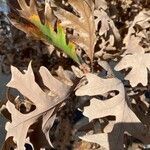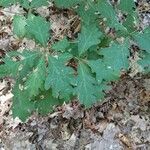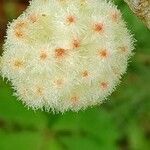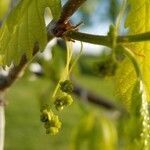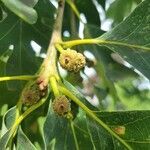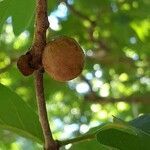Tall tree with light gray, coarsely flaky, shallowly furrowed bark and widely spreading branches; twigs soon glabrescent; lvs obovate or oblong-obovate, cuneate at base, thinly floccose beneath at first (the pubescence can be rolled off with one’s thumb), glabrous or nearly so at maturity, pale beneath, the lobes 3 or 4(5) pairs, ascending, oblong to ovate, rounded or rarely acute; acorns sessile or on pedicels to 4 cm, the cup deeply saucer-shaped, pubescent within, covering a fourth to a third of the nut; nut ovoid to cylindric-ovoid, 1.5–2.5 cm. Upland woods; Me. to Mich. and Minn., s. to n. Fla. and e. Tex. Extreme forms in which the lobes are scarcely more than large teeth may be distinguished from the chestnut-oaks by the lack of pubescence.
A medium to large tree. It grows to 35 m high. It spreads about 30 m wide. The trunk is 120 cm across. The leaves are 10-20 cm long and with 7-9 lobes. The leaves are usually widest above the middle. The lobes are rounded and narrow. There are deep notches between the lobes. The leaves are pinkish and downy when unfolded. The upper surface becomes bright green and they are paler underneath. They can turn reddish-purple in autumn. The acorns are 12-20 mm long. They occur either singly or in pairs. The cup is bowl shaped. It encloses about one quarter of the nut.
